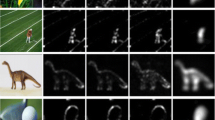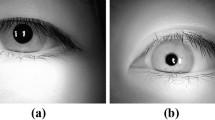Abstract
There are few restrictions in the image capture of mobile iris recognition, so the iris texture is easily interfered and the images may fail to meet the requirements of the identification. If the quality of captured iris images can be pre-evaluated, the unrecognizable iris images could be removed, which can reduce the operational burden and be more efficient. Therefore, an approach for iris image quality assessment based on saliency detection is proposed in this paper. First, Frequency-tuned (FT) method is used to detect image salient regions, then the binary image is obtained by segmenting saliency maps with threshold, and finally the image quality is evaluated according to the shape characteristics of the connected regions in binary images. As the results shown, the proposed method is capable of evaluating the image quality under the ideal and disturbing conditions, and removing the unrecognizable iris images because of the interference.
Access this chapter
Tax calculation will be finalised at checkout
Purchases are for personal use only
Similar content being viewed by others
References
Proenca, H.: Iris recognition: on the segmentation of degraded images acquired in the visible wavelength. IEEE Trans. Pattern Anal. Mach. Intell. 32(8), 502–1516 (2010)
Proença, H.: Iris recognition: a method to segment visible wavelength iris images acquired on-the-move and at-a-distance. In: Bebis, G., Boyle, R., Parvin, B., Koracin, D., Remagnino, P., Porikli, F., Peters, J., Klosowski, J., Arns, L., Chun, Y.K., Rhyne, T.-M., Monroe, L. (eds.) ISVC 2008, Part I. LNCS, vol. 5358, pp. 731–742. Springer, Heidelberg (2008)
Tan, K.: Automated segmentation of iris images using visible wave-length face images. In: 2011 IEEE Computer Society Conference on Computer Vision and Pattern Recognition Workshops (CVPRW), pp. 9–14 (2011)
Sankowski, G.: Reliable algorithm for iris segmentation in eye image. Image Vis. Comput. 28(2), 231–237 (2010)
Labati, R., Scotti, F.: Noisy iris segmentation with boundary regularization and reflections removal. Image Vis. Comput. 28(2), 270–277 (2010)
Sahmoud, S.A., Abuhaiba, I.S.: Efficient iris segmentation method in unconstrained environments. Pattern Recogn. 46, 3174–3185 (2013)
Abate, A.F., Frucci, M.: BIRD: watershed based iris detection for mobile devices. Pattern Recogn. Lett. 11, 1–9 (2014)
Hu, Y., Sirlantzis, K., Howells, G.: Improving color iris segmentation using a model selection technique. Pattern Recogn. Lett. 2, 1–9 (2015)
Achanta, R., Hemami, S., Estrada, F., Susstrunk, S.: Frequency-tuned salient region detection. In: IEEE International Conference on Computer Vision and Pattern Recognition, vol. 22, pp. 1597–1604 (2009)
Cheng, M.-M., Zhang, G.-X.: Global contrast based salient region detection. Comput. Vis. Pattern Recogn. 37, 409–416 (2011)
Liu, Y., Li, X.Q., Wang, L., Niu, Y.Z.: Interpolation-tuned salient region detection. Sci. China Inf. Sci. 57(1), 1–9 (2013)
Chen, Z., Xiong, S., Mao, Q., Fang, Z., Yu, X.: An improved saliency detection approach for Flying Apsaras in the Dunhuang Grotto Murals, China. Adv. Multimedia, 1–11 (2015)
Marr, D.: Vision: A Computational Investigation into the Human Representation and Processing of Visual Information. W. H. Freeman, San Francisco (1982)
Otsu, N.: A threshold selection method from gray-level histograms. IEEE Trans. Syst. Man Cybern. 9(1), 62–66 (1979)
Acknowledgment
All the images are from the dataset MICHE, all rights reserved.
Author information
Authors and Affiliations
Corresponding author
Editor information
Editors and Affiliations
Rights and permissions
Copyright information
© 2016 Springer International Publishing AG
About this paper
Cite this paper
Liu, X., Luo, Y., Yin, S., Gao, S. (2016). Iris Image Quality Assessment Based on Saliency Detection. In: You, Z., et al. Biometric Recognition. CCBR 2016. Lecture Notes in Computer Science(), vol 9967. Springer, Cham. https://doi.org/10.1007/978-3-319-46654-5_38
Download citation
DOI: https://doi.org/10.1007/978-3-319-46654-5_38
Published:
Publisher Name: Springer, Cham
Print ISBN: 978-3-319-46653-8
Online ISBN: 978-3-319-46654-5
eBook Packages: Computer ScienceComputer Science (R0)




